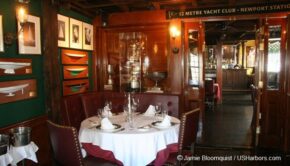Evolutionary Optimization of AC72 Catamarans
Published on August 1st, 2013
By Cupinfo.com
For the 2013 America’s Cup, Andrew Mason worked for Oracle Team USA on the optimization of their two AC72 Class catamarans using evolutionary modeling techniques to test design possibilities and “breed” faster yachts. His work for Oracle built on the innovative analysis of America’s Cup Class monohulls he brought to Alinghi’s successful defense of the Cup in 2007, which he explained in detail in this earlier article at CupInfo.
Here Andrew explains how these advanced methods were adapted to the creation of large, foiling, wing-sail multihulls for the America’s Cup; the thinking behind critical design decisions; and how this effort literally shaped the defending yachts.
How did you get involved with the Oracle team and what role did you play in the design of Oracle’s AC72’s?
I had worked with both Manolo Ruiz de Elvira and Mike Drummond at Alinghi prior to 2007 and I approached them in early 2011 regarding the optimization of Oracle’s hull designs. As a result of their support for the project I was contracted to the Oracle Racing design team from May 2011 to August 2012 to perform optimization of the hull shapes of the two Oracle AC72s.
The optimization group comprised myself, Manolo, Joseph Ozanne and Michel Kermarec. Manolo provided the parent designs and performed the computational fluid dynamics (CFD) analysis, Joseph provided the velocity prediction program (VPP) and continually refined it during the project, and Michel helped define which parameters were varied and provided a sanity check on the outputs from the optimizer.
What methods did you use for optimization?
These were similar to those used at Alinghi for the 2007 Cup, an evolutionary optimizer linked to a VPP and a race modeling program which ran thousands of races between each pair of designs modeled. The VPP used Neural Network-based regression models for lift, drag, and other parameters, and these were derived from CFD results for a large number of parent design variations. The resulting models were capable of producing quite accurate lift and drag values for any design within the design space we had defined.
Did the optimization project have a blank sheet of paper within the confines of the AC72 Class Rule, or were there some fundamental design decisions taken before beginning the process?
By the time the optimization project commenced Manolo had already been developing AC72 hulls for several months, so we started with quite a refined parent design. From there we had to decide the limits on how far the optimizer could modify the parent design before it became impractical or risky for other reasons. These risks included undesirable or unquantifiable effects on seakeeping or maneuvering, as well as the possibility that the CFD may not accurately calculate the effect of extreme hull features. So for example, we imposed limits on minimum and maximum beam, transom immersion and longitudinal center of buoyancy position, to name a few. In the end we had about 10 hull shape parameters that we were varying, and we explored all of that 10 dimensional design space.
For boat 2 we relaxed a few of the limits and locked other parameters where we were confident that we had close to optimal values. This reduced the dimensionality of the design space making the optimization process for boat 2 a little more efficient.








 We’ll keep your information safe.
We’ll keep your information safe.